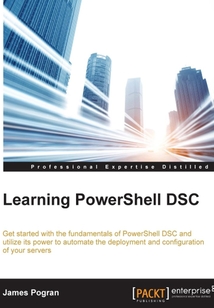舉報(bào) 

會(huì)員
Learning PowerShell DSC
最新章節(jié):
Index
Thisbookisintendedforsystemadministrators,developers,orengineerswhoareresponsibleforconfigurationmanagementandautomationandwishtolearnPowerShellDesiredStateConfigurationforefficientmanagement,configurationanddeploymentofsystemsandapplications.
目錄(72章)
倒序
- coverpage
- Learning PowerShell DSC
- Credits
- About the Author
- About the Reviewers
- www.PacktPub.com
- Support files eBooks discount offers and more
- Preface
- What this book covers
- What you need for this book
- Who this book is for
- Conventions
- Reader feedback
- Customer support
- Chapter 1. Introduction to PowerShell DSC
- What is PowerShell DSC?
- Why do we need Configuration Management?
- DSC quick wins
- A high level overview of DSC
- Why all the abstraction?
- How does DSC help me?
- DSC features
- PowerShell v4 DSC
- PowerShell v5 DSC
- Summary
- Chapter 2. DSC Architecture
- Overview
- Push and pull modes
- The general workflow
- The example workflow
- Configuration data
- Local Configuration Manager
- The DSC Pull Server
- Deployment considerations
- Summary
- Chapter 3. DSC Configuration Files
- Defining a DSC configuration script file
- Defining a DSC configuration data file
- Creating reusable DSC configurations
- Debugging and troubleshooting configuration script files
- Summary
- Chapter 4. DSC Resources
- What are DSC Resources?
- Creating a custom PowerShell v4 DSC Resource
- Creating a custom PowerShell v5 DSC Resource
- What makes a good DSC Resource
- Testing custom DSC Resources
- How do you find DSC Resources?
- Summary
- Chapter 5. Pushing DSC Configurations
- Tooling
- Setting things up
- Locally pushing DSC configurations
- Remotely pushing DSC configurations
- Things you must consider when pushing DSC configurations
- Summary
- Chapter 6. Pulling DSC Configurations
- Creating DSC Pull Servers
- Validating a DSC Pull Server install
- Registering target nodes with a DSC Pull Server
- Pulling DSC configurations with a DSC Pull Server
- DSC Pull Server and target node status
- Summary
- Chapter 7. Example Scenarios
- Real life DSC usage
- Setting up a common installation base
- Installing software
- A configuration management refresher
- Complicated deployments
- Handling change
- Summary
- Index 更新時(shí)間:2021-07-09 21:39:47
推薦閱讀
- Boost.Asio C++ Network Programming(Second Edition)
- Java FX應(yīng)用開發(fā)教程
- Visual Basic程序設(shè)計(jì)實(shí)驗(yàn)指導(dǎo)(第4版)
- 概率成形編碼調(diào)制技術(shù)理論及應(yīng)用
- 程序設(shè)計(jì)基礎(chǔ)教程:C語言
- Visual Basic程序設(shè)計(jì)
- 從零開始學(xué)C#
- Java零基礎(chǔ)實(shí)戰(zhàn)
- Python+Tableau數(shù)據(jù)可視化之美
- 區(qū)塊鏈技術(shù)進(jìn)階與實(shí)戰(zhàn)(第2版)
- 編程可以很簡單
- GitHub入門與實(shí)踐
- 區(qū)塊鏈國產(chǎn)化實(shí)踐指南:基于Fabric 2.0
- jQuery for Designers Beginner's Guide Second Edition
- Distributed Computing in Java 9
- Java 9 with JShell
- 百萬在線:大型游戲服務(wù)端開發(fā)
- Swift 2 Design Patterns
- 計(jì)算機(jī)邏輯設(shè)計(jì)
- SAP HANA平臺(tái)應(yīng)用開發(fā)
- 敏捷開發(fā)的藝術(shù)
- 輕松玩轉(zhuǎn)Python少兒編程
- 編程之美
- 跨平臺(tái)的移動(dòng)Web開發(fā)實(shí)戰(zhàn)(HTML5+CSS3)
- JavaWeb整合開發(fā)實(shí)例精通:Struts+Hibernate+Spring
- Python網(wǎng)絡(luò)爬蟲與數(shù)據(jù)分析從入門到實(shí)踐
- 大學(xué)信息基礎(chǔ)
- C#程序設(shè)計(jì)教程
- Ionic 2 Blueprints
- Android移動(dòng)開發(fā)項(xiàng)目式教程(第2版)

